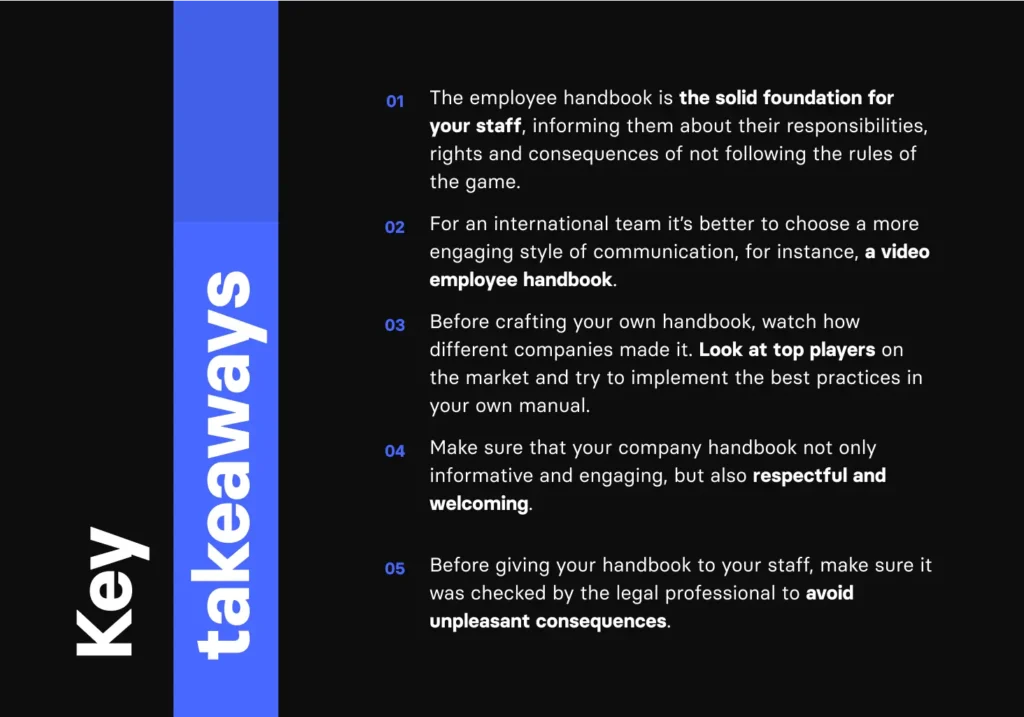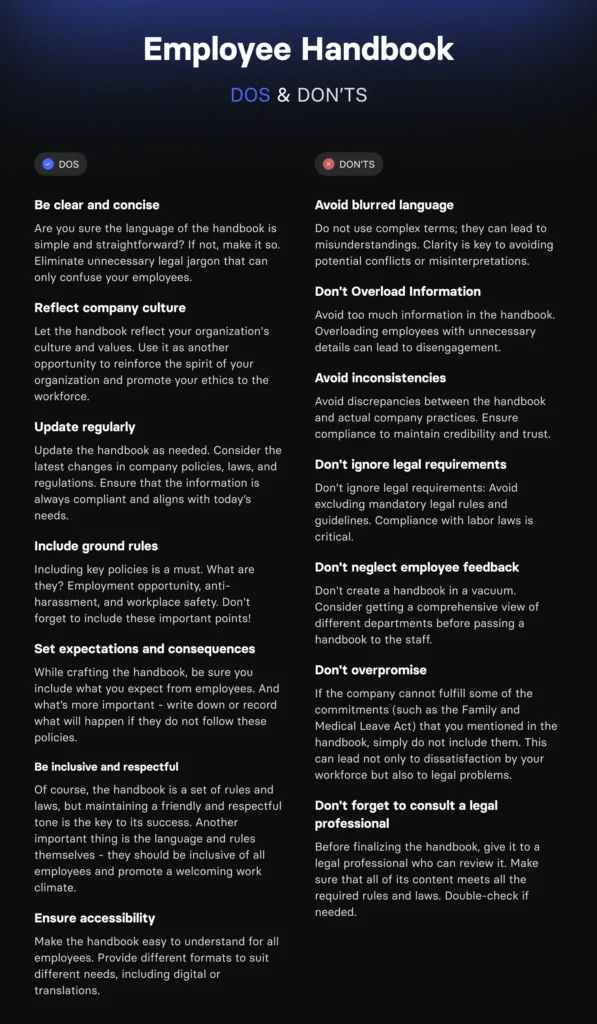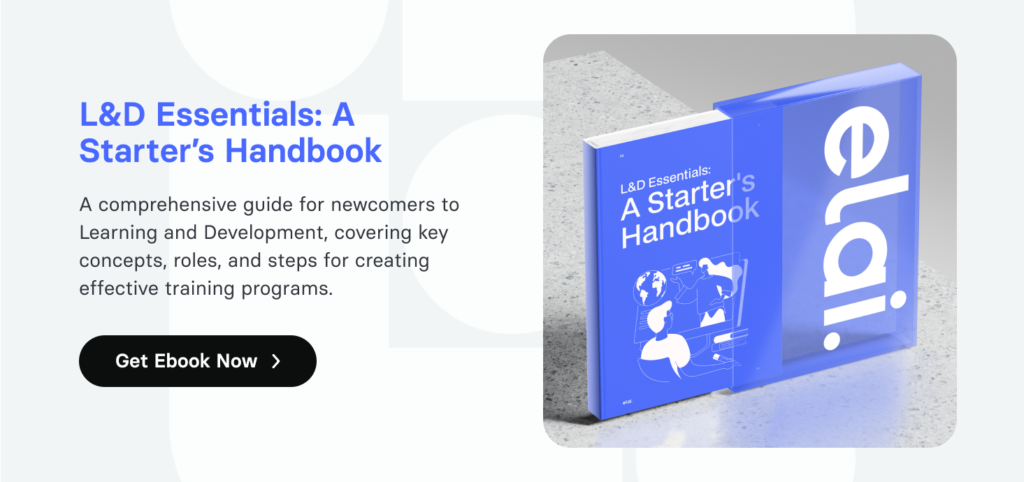Key Takeaways:
- The employee handbook is the solid foundation for your staff, informing them about their responsibilities, rights and consequences of not following the rules of the game.
- For an international team it’s better to choose a more engaging style of communication, for instance, a video employee handbook.
- Before crafting your own handbook, watch how different companies made it. Look at top players on the market and try to implement the best practices in your own manual.
- Make sure that your company handbook not only informative and engaging, but also respectful and welcoming.
- Before giving your handbook to your staff, make sure it was checked by the legal professional to avoid unpleasant consequences.

What is an employee handbook?
This document is an important reference that spells out the company’s ground rules, guidelines for workplace conduct, and general principles of organizational culture. The company handbook is often the first detailed material given to an employee. It contains information about the company’s ethics, its rules, and standard procedures. The purpose of the document is to be a resource of all the needed info for everyone in the company during their employment.
The employee handbook covers a range of topics – from employment and labor laws compliance and the company’s code of behavior to conflict resolution procedures. If a team member wants to have a clear understanding of their rights and responsibilities, the handbook provides them with the clue. Also, this book is like a framework to address and resolve issues effectively.
The reasons why employee handbook is important for your organization include such things:
- It eases your staff and managers work by giving them clear and understandable instructions on how to act in different situations.
- Sometimes it can be tough to deal with maternity leaves or other queries, but this document provides your managers with the right information, freeing their time for more important business.
- The handbook is a solid foundation for your employees on following the laws and legal procedures.
- Increase your protection if something goes wrong. For instance, your staff can be informed on how to act in social media in order to avoid problems in future
- The company handbook can set the tone of communicating with your employees. That’s why it’s very important to use tone of voice fat comply your company’s policies and values.
How to make a handbook more engaging
One of the ways to make the journey of studying the company employee handbook more engaging is by incorporating videos into it. This approach can transform the traditional reading experience into an interactive learning process. It’s obvious that videos offer a dynamic way to present information so that it makes complex policies and procedures easy to understand and remember.
If you have a global team that predominantly works remotely, a video employee handbook is the best choice. It can provide a consistent message across the organization, ensuring that all employees worldwide receive the same information. Videos also allow for creativity in presenting the company culture and values, the handbook in this case can include the brand’s identity and philosophy. It’s also easy to update the video content by editing and re-uploading it. Companies can ensure that their handbooks are current with the latest policies and legal requirements, maintaining compliance and relevancy.
Components of the Handbook
Begin your employee handbook with a warm and inviting introduction. It should reflect the spirit, tone of voice, and principles of your organization. To make it more personal, add a human touch, for instance, by incorporating your CEO’s employee handbook welcome statement. Give a brief overview of the company’s journey and organizational structure so that employees can get an idea of their workplace.
At the heart of the handbook, thoroughly outline the company’s operational guidelines and policies. This should encompass the company’s stance on equal opportunity, measures against harassment, and the provision for disability accommodations. Include vital operational details like working hours, attendance expectations, and guidelines for taking leave. Moreover, be transparent about how performance is evaluated, the criteria for promotions, and the approach to disciplinary actions.
Conclude the handbook with detailed information about the benefits and services available to employees. Cover aspects like health insurance, retirement plans, and employee assistance programs. It’s crucial to communicate these offerings clearly. Your employees should understand how to access and maximize these benefits and be engaged in all the processes.
Here are a few of the best employee handbook examples: Netflix’s handbook and Trello employee manual (surprisingly made in Trello).
Also, you can check out our own template of an employee handbook and craft your own example by following our structure or simply using our wording.
Dos and Don'ts in Creating Employee Handbook
When developing an employee handbook, consider all the dos and don’ts. Here is the easy checkbox for you.
Dos:
- Be clear and concise: Are you sure the language of the handbook is simple and straightforward? If not, make it so. Eliminate unnecessary legal jargon that can only confuse your employees.
- Reflect company culture: Let the handbook reflect your organization’s culture and values. Use it as another opportunity to reinforce the spirit of your organization and promote your ethics to the workforce.
- Update regularly: Update the handbook as needed. Consider the latest changes in company policies, laws, and regulations. Ensure that the information is always compliant and aligns with today’s needs.
- Include ground rules: Including key policies is a must. What are they? Employment opportunity, anti-harassment, and workplace safety. Don’t forget to include these important points!
- Set expectations and consequences: While crafting the handbook, be sure you include what you expect from employees. And what’s more important – write down or record what will happen if they do not follow these policies.
- Be inclusive and respectful: Of course, the handbook is a set of rules and laws, but maintaining a friendly and respectful tone is the key to its success. Another important thing is the language and rules themselves – they should be inclusive of all employees and promote a welcoming work climate.
- Ensure accessibility: Make the handbook easy to understand for all employees. Provide different formats to suit different needs, including digital or translations.
Don’ts:
- Avoid blurred language: Do not use complex terms; they can lead to misunderstandings. Clarity is key to avoiding potential conflicts or misinterpretations.
- Don’t Overload Information: Avoid too much information in the handbook. Overloading employees with unnecessary details can lead to disengagement.
- Avoid inconsistencies: Avoid discrepancies between the handbook and actual company practices. Ensure compliance to maintain credibility and trust.
- Don’t ignore legal requirements: Avoid excluding mandatory legal rules and guidelines. Compliance with labor laws is critical.
- Don’t neglect employee feedback: Don’t create a handbook in a vacuum. Consider getting a comprehensive view of different departments before passing a handbook to the staff.
- Don’t overpromise: If the company cannot fulfill some of the commitments (such as the Family and Medical Leave Act) that you mentioned in the handbook, simply do not include them. This can lead not only to dissatisfaction by your workforce but also to legal problems.
- Don’t forget to consult a legal professional: Before finalizing the handbook, give it to a legal professional who can review it. Make sure that all of its content meets all the required rules and laws. Double-check if needed.
In conclusion, an effective employee handbook is a dynamic tool that can lead to the company’s evolution. Of course, employee handbooks require regular updates and thoughtful consideration of their content and presentation. So to keep it relevant, clear, and inclusive, companies can ensure that their handbook is not just a document but a valuable resource for their entire team.

FAQ
What is an employee handbook?
An employee handbook is a document that includes all the policies, rules and laws that an organization’s workforce should follow. Like legal laws, ethics or workplace’s safety.
How to write an employee handbook?
To write an employee handbook, collect all the required information. Do research and find out how other companies make it. Start the handbook with a warming introduction, overview the company’s journey, and write down your values and ethical standards. Include the rules and policies your staff should follow. Do not forget to be respectful and welcoming.
What does an employee handbook contain?
Employee handbook usually contains: welcome message, company history and culture, employment basics, workplace policies, code of conduct, compensation and performance reviews, healthy and safety policies etc.
What should be included in an employee handbook?
Employee handbooks should include company overview, its ethical standards and values, as well as laws it follows, benefits for employees and consequences of not following the rules and laws.

